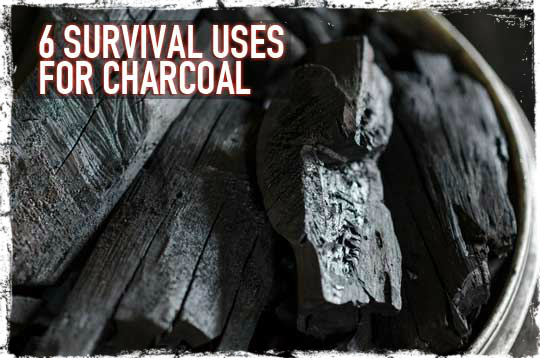
Survival Uses for Charcoal
There is charcoal and then there is activated charcoal or activated carbon. Both are the byproduct of removing water and other constituents from animal and vegetation substances. This articles’ focus however, will be on charcoal made from hardwoods and its uses in a survival situation.
Activated charcoal can be made from various materials that are combined together then heated at high temperatures. Then the substance is further processed using chemicals to make the substance more porous.
Activated charcoal can be made in your own backyard but the process is laborious and typically requires calcium chloride at 25 percent and the ability to heat the carbon beyond 900ᵒF/482ᵒC. Commercial producers often times inject steam into the heating chambers to remove oxygen to help create activated charcoal.
In a survival situation, you would allow hardwood pieces to char well on all sides and then remove from the heat. To stop the burning process you can smother the pieces with sand, soil or wood ash. Once cooled you would break the charcoal into small pieces and then grind into a fine powder. Use a pestle and mortar to process the charcoal. You can use a small stick or stone as a pestle and any type of bowl as a mortar to grind the charcoal.
Uses for Charcoal in a Survival Situation
1.) Fire for Cooking and Heat
Larger pieces of charcoal once cooled can be transported for use at other times for cooking and heating. If you are attempting self-rescue and are on the move then it is recommended that you make charcoal every night to carry with you. You can end up in areas with limited combustibles for your fire at night. Charcoal pieces can be ignited with a very small fire and once ignited can provide you with heat and the ability to cook for hours.
2). Water Filtration
Charcoal once ground up makes an ideal water filtration medium that can be used alone or in combination with other mediums such as sand and gravel. Charcoal can remove debris, sediment and other contaminates such as pesticides, herbicides, odors and fuels from water along with waterborne cysts that can harbor deadly bacteria.
3.) Mask Odors
Use charcoal to absorb odors and moisture from shoes, socks, and clothing and to absorb moisture that may cause fungus or mold from equipment. Keep in mind charcoal will stain clothing/cloth and you may not be able to remove the stain. Wrap the charcoal in cloth and place it so the charcoal is exposed to the air, and yet will not spill onto the clothing. Place a small piece of charcoal inside of shoes at night.
Use it to mask human scent on snares or traps by rubbing onto the surfaces. Use ground charcoal in latrines to “sweeten” the pit if sheltering in place. Sprinkle the charcoal into the pit after each use.
4.) Writing Instrument
Use charcoal to leave messages/signs on rocks or pieces of bark. You can also use it to write on standard writing paper. Keep in mind the charcoal messages may very well wash away if the messages are subjected to rain or snow. If you are lost and on the move you can leave messages and signs behind for rescuers.
5.) Camouflage/Sun Reflector
Use charcoal to reduce “skin shine” if you are practicing evasion tactics while in a survival situation. Rub the charcoal on cheekbones, forehead, and hands and on any exposed skin to eliminate skin reflection and to break up the natural patterns the human eye sees. The human eye immediately tries to recognize a face in any object so the objective for camouflage applications is to break up the face into patterns that cannot be recognized by the human eye. Use charcoal under the eyes to reduce glare.
6.) Medical Uses
The information provided is for informational purposes only and should not be considered medical advice. When in doubt always seek the advice of a medical professional
Charcoal has the unique ability to absorb harmful toxins and not release those toxins. Activated charcoal is routinely given to individuals that have ingested poisons or other harmful toxins. Charcoal you make in a survival situation will provide the same results but keep in mind activated charcoal is more porous.
If you use charcoal you make to absorb poisons from the stomach or intestines, you would have to use more. Most experts would tell you that charcoal ingested in large amounts would not be toxic but will cause constipation. Charcoal can absorb the nutrients from vitamins and other supplements as well. It is important that you or anyone else consume plenty of clean water when ingesting charcoal to rid the body of toxins.
If you suspect or know, you or someone else has ingested a poison then make a slurry by mixing finely ground charcoal with clean water and take immediately. Charcoal will not remove toxins already absorbed into the blood stream. It will only absorb what it comes in contact with typically in the stomach or intestines. The charcoal absorbs and will not release the toxins and then carries them out of the body.
Make a charcoal poultice by wrapping ground charcoal in cloth and securing to an infected or non-infected wound to help draw the infection out and to absorb moisture to help prevent an infection.
There are a number of websites out there that tout the benefits of ingesting charcoal on a regular basis. Do your own research and due diligence.
Charcoal has been used for thousands of years to absorb toxins from the body and while not considered or classified as a drug many emergency rooms routinely administer activated charcoal to persons suspected of or known to have ingested poison (s).
Some poison control centers recommend that parents have activated charcoal on hand to administer to children that may have ingested a poison. (Loyola Medicine).
Loyola Medicine. (n.d.). Retrieved 2014, from http://www.luhs.org/depts/emsc/poison.htm